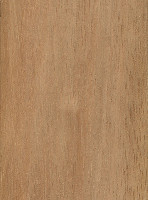Light Red Meranti

Common Name(s): Light Red Meranti, Lauan, Philippine Mahogany
Scientific Name: Shorea spp.
Distribution: Southeast Asia
Tree Size: 65-130 ft (20-40 m) tall, 3-6 ft (1-2 m) trunk diameter
Average Dried Weight: 30 lbs/ft3 (480 kg/m3)
Specific Gravity (Basic, 12% MC): .40, .48
Janka Hardness: 550 lbf (2,460 N)
Modulus of Rupture: 11,210 lbf/in2 (77.3 MPa)
Elastic Modulus: 1,652,000 lbf/in2 (11.39 GPa)
Crushing Strength: 6,120 lbf/in2 (42.2 MPa)
Shrinkage: Radial: 4.1%, Tangential: 7.8%, Volumetric: 12.6%, T/R Ratio: 1.9
Color/Appearance: Color can be highly variable depending upon the species: ranging from a pale straw color, to a darker reddish brown.
Grain/Texture: Has a coarse texture with medium to large pores. Grain is sometimes interlocked.
Endgrain: Diffuse-porous; large to very large pores in no specific arrangement, few to very few; solitary and radial multiples of 2-3; tyloses occasionally present; parenchyma vasicentric, winged, and banded with embedded resin canals; narrow to medium rays, spacing normal.
Rot Resistance: Reported as non-durable in regard to decay resistance, and is also susceptible to insect attack.
Workability: Typically easy to work, due to its low density. Though some rough or ragged surfaces may be left while sanding, and it may be necessary to sand up to a finer grit to obtain a satisfactory finish. Some species may have a slight blunting effect on tools due to small levels of silica present in the wood. Glues, stains, and finishes well.
Odor: No characteristic odor.
Allergies/Toxicity: Although severe reactions are quite uncommon, Meranti in the Shorea genus has been reported to cause eye, throat, and skin irritation. See the articles Wood Allergies and Toxicity and Wood Dust Safety for more information.
Pricing/Availability: Meranti is widely harvested and available worldwide. It should be moderately priced despite the fact that it is imported.
Sustainability: Meranti is not listed in the CITES Appendices, but many species in the Shorea genus are on the IUCN Red List. The majority of Shorea species are listed as being critically endangered due to a population reduction of over 80% in the past three generations, caused by a decline in its natural range, and exploitation.
Common Uses: Plywood, interior furniture, general construction, concrete forms, as well as a number of other general utility purposes.
Comments: Sometimes referred to as “Lauan,” wood in the Shorea genus is very commonly used in southeast Asia, and there is an abundance of variety between the difference species: each with different working properties, appearances, and mechanical strength values.
The five main groupings for Meranti (Lauan) are: Light Red Meranti, Dark Red Meranti, White Meranti, Yellow Meranti, and Balau. The strength and mechanical values listed at the top of this page represent the average of a handful of species within the corresponding group.
Also called Philippine Mahogany, Meranti bears no relation to what is considered to be “true” mahogany in the Swietenia and Khaya genera.
Related Species:
- Balau (Shorea spp.)
- Dark Red Meranti (Shorea spp.)
- White Meranti (Shorea spp.)
- Yellow Meranti (Shorea spp.)
- Lauan
- Philippine Mahogany
- Mahogany Mixups: the Lowdown
- Restricted and Endangered Wood Species

